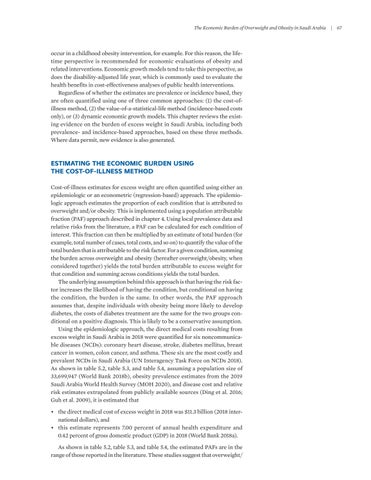The Economic Burden of Overweight and Obesity in Saudi Arabia
occur in a childhood obesity intervention, for example. For this reason, the lifetime perspective is recommended for economic evaluations of obesity and related interventions. Economic growth models tend to take this perspective, as does the disability-adjusted life year, which is commonly used to evaluate the health benefits in cost-effectiveness analyses of public health interventions. Regardless of whether the estimates are prevalence or incidence based, they are often quantified using one of three common approaches: (1) the cost-of- illness method, (2) the value-of-a-statistical-life method (incidence-based costs only), or (3) dynamic economic growth models. This chapter reviews the existing evidence on the burden of excess weight in Saudi Arabia, including both prevalence- and incidence-based approaches, based on these three methods. Where data permit, new evidence is also generated.
ESTIMATING THE ECONOMIC BURDEN USING THE COST-OF-ILLNESS METHOD Cost-of-illness estimates for excess weight are often quantified using either an epidemiologic or an econometric (regression-based) approach. The epidemiologic approach estimates the proportion of each condition that is attributed to overweight and/or obesity. This is implemented using a population attributable fraction (PAF) approach described in chapter 4. Using local prevalence data and relative risks from the literature, a PAF can be calculated for each condition of interest. This fraction can then be multiplied by an estimate of total burden (for example, total number of cases, total costs, and so on) to quantify the value of the total burden that is attributable to the risk factor. For a given condition, summing the burden across overweight and obesity (hereafter overweight/obesity, when considered together) yields the total burden attributable to excess weight for that condition and summing across conditions yields the total burden. The underlying assumption behind this approach is that having the risk factor increases the likelihood of having the condition, but conditional on having the condition, the burden is the same. In other words, the PAF approach assumes that, despite individuals with obesity being more likely to develop diabetes, the costs of diabetes treatment are the same for the two groups conditional on a positive diagnosis. This is likely to be a conservative assumption. Using the epidemiologic approach, the direct medical costs resulting from excess weight in Saudi Arabia in 2018 were quantified for six noncommunicable diseases (NCDs): coronary heart disease, stroke, diabetes mellitus, breast cancer in women, colon cancer, and asthma. These six are the most costly and prevalent NCDs in Saudi Arabia (UN Interagency Task Force on NCDs 2018). As shown in table 5.2, table 5.3, and table 5.4, assuming a population size of 33,699,947 (World Bank 2018b), obesity prevalence estimates from the 2019 Saudi Arabia World Health Survey (MOH 2020), and disease cost and relative risk estimates extrapolated from publicly available sources (Ding et al. 2016; Guh et al. 2009), it is estimated that • the direct medical cost of excess weight in 2018 was $11.3 billion (2018 international dollars), and • this estimate represents 7.00 percent of annual health expenditure and 0.42 percent of gross domestic product (GDP) in 2018 (World Bank 2018a). As shown in table 5.2, table 5.3, and table 5.4, the estimated PAFs are in the range of those reported in the literature. These studies suggest that overweight/
|
67






